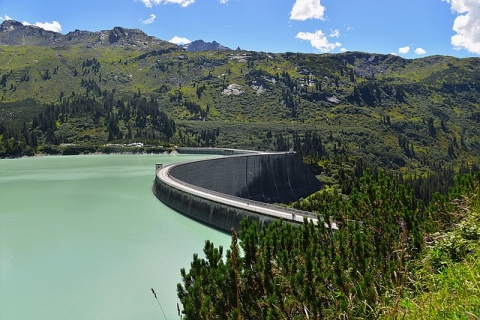Design & Build a Dam
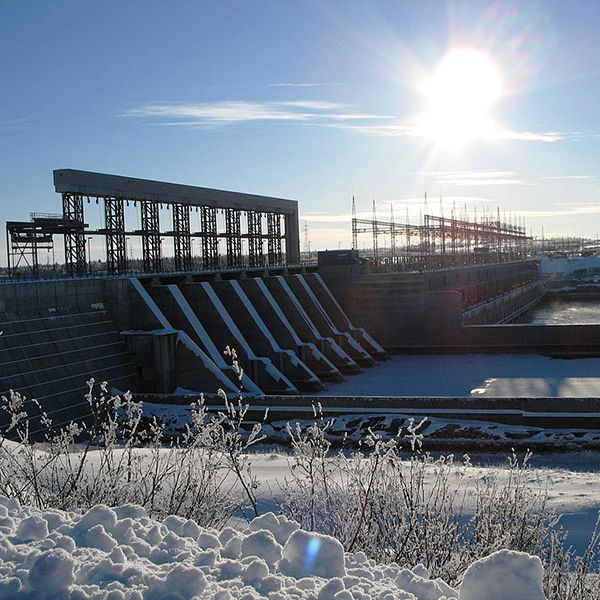
La Grande-1 dam in Quebec (Jeangagnon P199 [CC BY-SA 3.0], Wikimedia Commons)
Students will work collaboratively to design and build a dam that holds back a given volume of water for a certain time.
Overview
Students create and test a prototype dam that holds back a given volume of water for a certain time.
Timing
30-45 minutes
Setting the Stage
Prior Skills and Knowledge
To successfully participate in this Design & Build, students should:
- be able to work with basic materials (e.g., clay, pebbles, sticks, water)
- be familiar with the properties of familiar solids and liquids.
Context
Flowing water, in the form of rivers, is a natural resource that humans use in various ways. For example, humans create river dams. Dams are barriers that can stop, slow, or redirect the flow of water. Dams can be used to help stop flooding. They can also be used for other purposes, such as channeling flowing water for electricity generation (hydroelectricity).
In this Design & Build challenge, students will work collaboratively to develop their designing and building skills as they create and test a prototype dam that holds back a given volume of water for a certain time.
This design and build could begin from:
- questions and/or comments that arise after showing students videos of different types of dams. Ideally, select a range of dams so that students can see a variety of building techniques.
- going on a field trip or exploring photos of local dams. Discuss using questions such as:
- “What materials do you think this dam is made of?”
- “Why do you think this dam was built here?”
- reading a book such as We’re Going to Build a Dam by Gillian McClure or Build, Beaver, Build! Life at the Longest Beaver Dam by Sandra Markle, or completing the Animal Adaptations lesson. Discuss using questions such as:
- “Would a human-made dam have the same impact on the environment as a beaver dam? Why or why not?”
- “Why did the boys build a dam? What might you have done differently?”
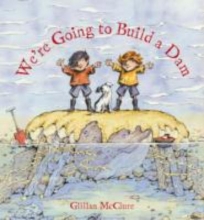
Design Criteria
As a class, students brainstorm criteria that their prototype dam must meet. Educators may choose to add other criteria that are curriculum-specific, such as using joiners/fasteners, using specific measurements, using specific materials, etc.
Design criteria examples:
- Dam must be the width of a container
- Dam must be able to hold back x ml of water for xx amount of time.
- Dam must be x cm high and x cm long
Details
These will depend on if you would like students to complete the Design & Build task inside or outside
- access to water
- blocks, interlocking
- container, plastic, clear, plastic flat-bottomed
- cup, measuring, plastic
- image of dam
- leaves
- metre stick
- plasticine, hard, preferably brown or gray
- craft sticks
- rocks, small
- drinking straws
- string
- tape
- toothpicks
- towel
- twigs
- paper house (optional)
- Collect an assortment of recycled and new materials that students will use to construct the prototype dams. The materials list above is only a ‘suggested’ list.
- Set up material sourcing stations, organized by type of material. Alternatively, organize and provide an assortment of materials.

Students develop Design & Build skills as they design, build and test a prototype dam that holds back water.
Students will follow the steps of the Design & Build process:
- identify the problem to be solved/needs to be met
- brainstorm criteria that the prototype must meet
- share their questions and ideas for a solution to the problem / need
- discuss the advantages and disadvantages of each in order to select a potential solution to test
- visualize what the solution might look like and make design sketches based on their visualizations
- develop a design plan (e.g., identify the tasks or key steps involved in developing the solution, make decisions about tools and materials that will be needed, including labelled sketches)
- build / develop the design idea based on their sketches and design plan
- test their prototypes based on the design criteria
- modify the prototype and retest it against the design criteria as necessary
- reflect on their results and identify things that could be done to improve their prototypes

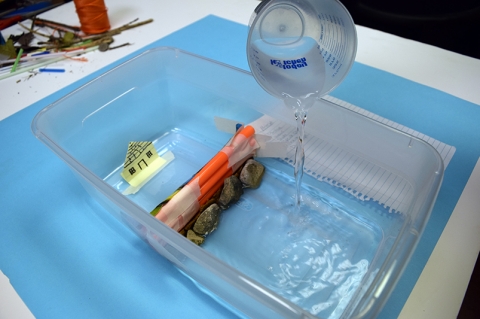
Observe and document, using anecdotal comments, photos and/or video recordings, students’ ability to:
- Work Collaboratively – students work collaboratively to complete a task and evaluate their group processes throughout the Design & Build process
- Generate Ideas – students use idea generation skills and strategies, such as brainstorming, to identify possible solutions as well as make decisions about the pros and cons of each solution
- Communicate – students communicate their thinking and learning in words, sketches, photos, videos, etc. (e.g., in identifying the problem, in design plans that include 2D design sketches and key design steps/tasks, in lists of materials/equipment/tools)
- Work Safely – students demonstrate safe practices when using a variety of tools and materials while prototyping
- Test – students use skills of observing and recording data as they test their prototypes
- Reflect – students reflect on the results of their prototype testing and suggest things that they might do differently to improve their prototypes
| Students: Saying, Doing, Representing |
Educator: Interactions: Responding, Challenging |
|---|---|
| Students identify and refine the problem to be solved/need to be met. |
|
| Students brainstorm and record criteria for the dam. |
|
| Students visualize what the solution might look like and make design sketches based on their visualizations. |
|
| Students develop a design plan (e.g., steps in creating a prototype, decisions about tools and materials). |
|
| Students build/develop and test the design idea based on their sketches and design plan (create the prototype). |
|
| Students modify the prototype and retest it against the design criteria as necessary. |
|
| Students reflect on the results of their testing and identify things that could be done differently in the future. |
|
Literacy
- Ask questions (e.g., “Why do we need dams?” “How do dams help the environment? How do dams harm the environment?”)
- Communicate thoughts, feelings and ideas (e.g. brainstorm criteria for a dam; talk about ways in which human-made dams have changed and developed over time; discuss how dams impact the surrounding environment, including humans and other living things)
Mathematical Thinking
- Measure the volume of water (ml) used for each test of the dams
- Measure the time that the dam holds back the water (before breaking)
Visual Arts
- Sculpt the dam prototype
If your students are interested in learning more, the following may provoke their curiosity:
- Depending on what is accessible in your local community, you can increase the complexity of the dam-building challenge by having the students create their dams outside using materials they find. How well does the dam hold back water? How large can they make their dam? What constraints do they have and what problems do they run into?
- Compare all the models that the class has produced. What was different about each of the models? What were their strengths and weaknesses? What role did different materials play in the success or failure of each dam prototype?
- Invite students to explore photos of beaver dams, lodges and damage on trees caused by beavers. Discuss using questions such as:
- “How do dams made by beavers differ from dams made by people?”
- “What materials do beavers use to make their dams?”
- “How do beavers cut down trees?”
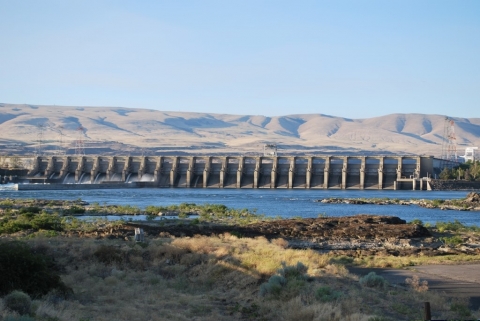
Books

We're Going to Build a Dam
by Gillian McClure
Two boys and a dog use a variety of materials to try to build a dam that will stop a stream from flowing into the sea.
ISBN: 9780956510846

Beaver, Beaver Build! Life at the Longest Beaver Dam
by Sandra Markle
Follows a year in the life of a young male beaver as he swims, plays, helps his family build and repair their dam and lodge, and learns how to flap his tail to ward off predators.
ISBN: 9781467749008
Videos
How the 726-Foot-Tall Hoover Dam Was Built Ahead of Schedule (2012)
Smithsonian Channel (3:32 min.) The world's biggest dam at the time of its construction, Hoover Dam solved the problem of the overflowing Colorado river with sleek design and brilliant American engineering.
Constructing the Hoover Dam (2016)
Science Channel (2:54 min.) Video discussing the building of the Hoover Dam and some of the challenges.
Dams in Canada (2019)
Canadian Dam Association - Webpage about dams in Canada. Contains a photo gallery.
Role of Dams (2019)
International Commission on Large Dams (ICLD) - Website that summarizes the different purposes of dams.
Materials
These will depend on if you would like students to complete the Design & Build task inside or outside
- access to water
- blocks, interlocking
- container, plastic, clear, plastic flat-bottomed
- cup, measuring, plastic
- image of dam
- leaves
- metre stick
- plasticine, hard, preferably brown or gray
- craft sticks
- rocks, small
- drinking straws
- string
- tape
- toothpicks
- towel
- twigs
- paper house (optional)
Preparation
- Collect an assortment of recycled and new materials that students will use to construct the prototype dams. The materials list above is only a ‘suggested’ list.
- Set up material sourcing stations, organized by type of material. Alternatively, organize and provide an assortment of materials.

What to Do
Students develop Design & Build skills as they design, build and test a prototype dam that holds back water.
Students will follow the steps of the Design & Build process:
- identify the problem to be solved/needs to be met
- brainstorm criteria that the prototype must meet
- share their questions and ideas for a solution to the problem / need
- discuss the advantages and disadvantages of each in order to select a potential solution to test
- visualize what the solution might look like and make design sketches based on their visualizations
- develop a design plan (e.g., identify the tasks or key steps involved in developing the solution, make decisions about tools and materials that will be needed, including labelled sketches)
- build / develop the design idea based on their sketches and design plan
- test their prototypes based on the design criteria
- modify the prototype and retest it against the design criteria as necessary
- reflect on their results and identify things that could be done to improve their prototypes


Assessment
Observe and document, using anecdotal comments, photos and/or video recordings, students’ ability to:
- Work Collaboratively – students work collaboratively to complete a task and evaluate their group processes throughout the Design & Build process
- Generate Ideas – students use idea generation skills and strategies, such as brainstorming, to identify possible solutions as well as make decisions about the pros and cons of each solution
- Communicate – students communicate their thinking and learning in words, sketches, photos, videos, etc. (e.g., in identifying the problem, in design plans that include 2D design sketches and key design steps/tasks, in lists of materials/equipment/tools)
- Work Safely – students demonstrate safe practices when using a variety of tools and materials while prototyping
- Test – students use skills of observing and recording data as they test their prototypes
- Reflect – students reflect on the results of their prototype testing and suggest things that they might do differently to improve their prototypes
Co-constructed Learning
| Students: Saying, Doing, Representing |
Educator: Interactions: Responding, Challenging |
|---|---|
| Students identify and refine the problem to be solved/need to be met. |
|
| Students brainstorm and record criteria for the dam. |
|
| Students visualize what the solution might look like and make design sketches based on their visualizations. |
|
| Students develop a design plan (e.g., steps in creating a prototype, decisions about tools and materials). |
|
| Students build/develop and test the design idea based on their sketches and design plan (create the prototype). |
|
| Students modify the prototype and retest it against the design criteria as necessary. |
|
| Students reflect on the results of their testing and identify things that could be done differently in the future. |
|
Cross-curricular Connections
Literacy
- Ask questions (e.g., “Why do we need dams?” “How do dams help the environment? How do dams harm the environment?”)
- Communicate thoughts, feelings and ideas (e.g. brainstorm criteria for a dam; talk about ways in which human-made dams have changed and developed over time; discuss how dams impact the surrounding environment, including humans and other living things)
Mathematical Thinking
- Measure the volume of water (ml) used for each test of the dams
- Measure the time that the dam holds back the water (before breaking)
Visual Arts
- Sculpt the dam prototype
Extending the Learning
If your students are interested in learning more, the following may provoke their curiosity:
- Depending on what is accessible in your local community, you can increase the complexity of the dam-building challenge by having the students create their dams outside using materials they find. How well does the dam hold back water? How large can they make their dam? What constraints do they have and what problems do they run into?
- Compare all the models that the class has produced. What was different about each of the models? What were their strengths and weaknesses? What role did different materials play in the success or failure of each dam prototype?
- Invite students to explore photos of beaver dams, lodges and damage on trees caused by beavers. Discuss using questions such as:
- “How do dams made by beavers differ from dams made by people?”
- “What materials do beavers use to make their dams?”
- “How do beavers cut down trees?”

Supporting Media
Books

We're Going to Build a Dam
by Gillian McClure
Two boys and a dog use a variety of materials to try to build a dam that will stop a stream from flowing into the sea.
ISBN: 9780956510846

Beaver, Beaver Build! Life at the Longest Beaver Dam
by Sandra Markle
Follows a year in the life of a young male beaver as he swims, plays, helps his family build and repair their dam and lodge, and learns how to flap his tail to ward off predators.
ISBN: 9781467749008
Videos
How the 726-Foot-Tall Hoover Dam Was Built Ahead of Schedule (2012)
Smithsonian Channel (3:32 min.) The world's biggest dam at the time of its construction, Hoover Dam solved the problem of the overflowing Colorado river with sleek design and brilliant American engineering.
Constructing the Hoover Dam (2016)
Science Channel (2:54 min.) Video discussing the building of the Hoover Dam and some of the challenges.
Learn More
Dams in Canada (2019)
Canadian Dam Association - Webpage about dams in Canada. Contains a photo gallery.
Role of Dams (2019)
International Commission on Large Dams (ICLD) - Website that summarizes the different purposes of dams.
